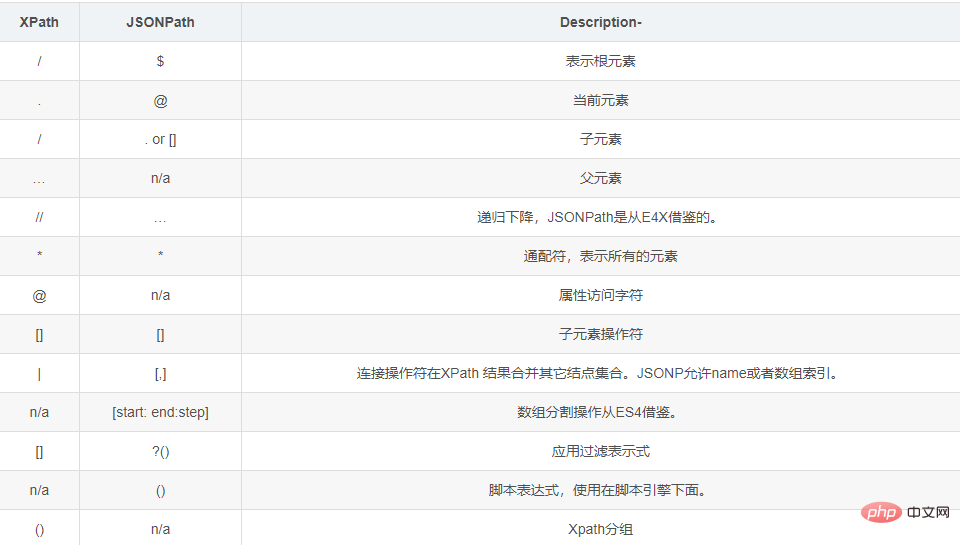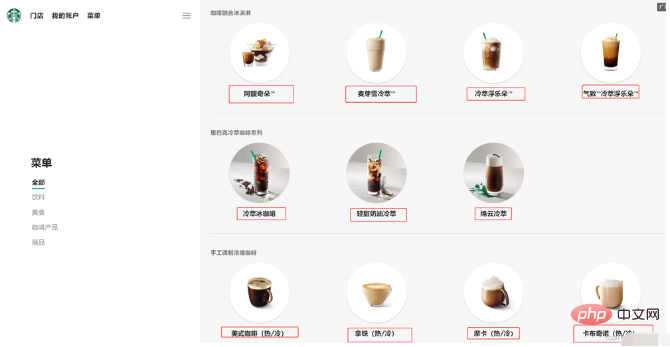如何使用 Python 實作 xpath、JsonPath 和 bs4?
1.xpath
1.1 xpath使用
google提前安裝xpath插件,按ctrl shift x 出現小黑框
#安裝lxml函式庫
pip install lxml ‐i https://pypi.douban.com/simple匯入lxml.etree
from lxml import etreeetree.parse() 解析本機檔案
html_tree = etree.parse('XX.html')etree.HTML() 伺服器回應檔
html_tree = etree.HTML(response.read().decode('utf‐8')# .html_tree.xpath(xpath路徑)
1.2 xpath基本語法
1.路徑查詢
找出所有子孫節點,不考慮層級關係
找直接子節點
#2.謂詞查詢
//div[@id] //div[@id="maincontent"]
3.屬性查詢
//@class
4.模糊查詢
//div[contains(@id, "he")] //div[starts‐with(@id, "he")]
5.內容查詢
//div/h2/text()
6.邏輯運算
//div[@id="head" and @class="s_down"] //title | //price
1.3 範例
#xpath .html
<!DOCTYPE html>
<html lang="en">
<head>
<meta charset="UTF-8"/>
<title>Title</title>
</head>
<body>
<ul>
<li id="l1" class="class1">北京</li>
<li id="l2" class="class2">上海</li>
<li id="d1">广州</li>
<li>深圳</li>
</ul>
</body>
</html>from lxml import etree # xpath解析 # 本地文件: etree.parse # 服务器相应的数据 response.read().decode('utf-8') etree.HTML() tree = etree.parse('xpath.html') # 查找url下边的li li_list = tree.xpath('//body/ul/li') print(len(li_list)) # 4 # 获取标签中的内容 li_list = tree.xpath('//body/ul/li/text()') print(li_list) # ['北京', '上海', '广州', '深圳'] # 获取带id属性的li li_list = tree.xpath('//ul/li[@id]') print(len(li_list)) # 3 # 获取id为l1的标签内容 li_list = tree.xpath('//ul/li[@id="l1"]/text()') print(li_list) # ['北京'] # 获取id为l1的class属性值 c1 = tree.xpath('//ul/li[@id="l1"]/@class') print(c1) # ['class1'] # 获取id中包含l的标签 li_list = tree.xpath('//ul/li[contains(@id, "l")]/text()') print(li_list) # ['北京', '上海'] # 获取id以d开头的标签 li_list = tree.xpath('//ul/li[starts-with(@id,"d")]/text()') print(li_list) # ['广州'] # 获取id为l2并且class为class2的标签 li_list = tree.xpath('//ul/li[@id="l2" and @class="class2"]/text()') print(li_list) # ['上海'] # 获取id为l2或id为d1的标签 li_list = tree.xpath('//ul/li[@id="l2"]/text() | //ul/li[@id="d1"]/text()') print(li_list) # ['上海', '广州']
1.4 爬取百度搜尋按鈕的value
import urllib.request
from lxml import etree
url = 'http://www.baidu.com'
headers = {
'User-Agent': 'Mozilla/5.0 (Windows NT 10.0; Win64; x64) AppleWebKit/537.36 (KHTML, like Gecko) Chrome/103.0.0.0 Safari/537.36'
}
request = urllib.request.Request(url=url, headers=headers)
response = urllib.request.urlopen(request)
content = response.read().decode('utf-8')
tree = etree.HTML(content)
value = tree.xpath('//input[@id="su"]/@value')
print(value)
1.5 爬取站長素材的圖片
# 需求 下载的前十页的图片
# https://sc.chinaz.com/tupian/qinglvtupian.html 1
# https://sc.chinaz.com/tupian/qinglvtupian_page.html
import urllib.request
from lxml import etree
def create_request(page):
if (page == 1):
url = 'https://sc.chinaz.com/tupian/qinglvtupian.html'
else:
url = 'https://sc.chinaz.com/tupian/qinglvtupian_' + str(page) + '.html'
headers = {
'User-Agent': 'Mozilla/5.0 (Windows NT 10.0; Win64; x64) AppleWebKit/537.36 (KHTML, like Gecko) Chrome/92.0.4515.159 Safari/537.36',
}
request = urllib.request.Request(url=url, headers=headers)
return request
def get_content(request):
response = urllib.request.urlopen(request)
content = response.read().decode('utf-8')
return content
def down_load(content):
# 下载图片
# urllib.request.urlretrieve('图片地址','文件的名字')
tree = etree.HTML(content)
name_list = tree.xpath('//div[@id="container"]//a/img/@alt')
# 一般设计图片的网站都会进行懒加载
src_list = tree.xpath('//div[@id="container"]//a/img/@src2')
print(src_list)
for i in range(len(name_list)):
name = name_list[i]
src = src_list[i]
url = 'https:' + src
urllib.request.urlretrieve(url=url, filename='./loveImg/' + name + '.jpg')
if __name__ == '__main__':
start_page = int(input('请输入起始页码'))
end_page = int(input('请输入结束页码'))
for page in range(start_page, end_page + 1):
# (1) 请求对象的定制
request = create_request(page)
# (2)获取网页的源码
content = get_content(request)
# (3)下载
down_load(content)2. JsonPath
2.1 pip安裝
pip install jsonpath
2.2 jsonpath的使用
obj = json.load(open('json文件', 'r', encoding='utf‐8')) ret = jsonpath.jsonpath(obj, 'jsonpath语法')
JSONPath語法元素和對應XPath元素的對比:

範例:
#jsonpath.json
{ "store": {
"book": [
{ "category": "修真",
"author": "六道",
"title": "坏蛋是怎样练成的",
"price": 8.95
},
{ "category": "修真",
"author": "天蚕土豆",
"title": "斗破苍穹",
"price": 12.99
},
{ "category": "修真",
"author": "唐家三少",
"title": "斗罗大陆",
"isbn": "0-553-21311-3",
"price": 8.99
},
{ "category": "修真",
"author": "南派三叔",
"title": "星辰变",
"isbn": "0-395-19395-8",
"price": 22.99
}
],
"bicycle": {
"author": "老马",
"color": "黑色",
"price": 19.95
}
}
}import json
import jsonpath
obj = json.load(open('jsonpath.json', 'r', encoding='utf-8'))
# 书店所有书的作者
author_list = jsonpath.jsonpath(obj, '$.store.book[*].author')
print(author_list) # ['六道', '天蚕土豆', '唐家三少', '南派三叔']
# 所有的作者
author_list = jsonpath.jsonpath(obj, '$..author')
print(author_list) # ['六道', '天蚕土豆', '唐家三少', '南派三叔', '老马']
# store下面的所有的元素
tag_list = jsonpath.jsonpath(obj, '$.store.*')
print(
tag_list) # [[{'category': '修真', 'author': '六道', 'title': '坏蛋是怎样练成的', 'price': 8.95}, {'category': '修真', 'author': '天蚕土豆', 'title': '斗破苍穹', 'price': 12.99}, {'category': '修真', 'author': '唐家三少', 'title': '斗罗大陆', 'isbn': '0-553-21311-3', 'price': 8.99}, {'category': '修真', 'author': '南派三叔', 'title': '星辰变', 'isbn': '0-395-19395-8', 'price': 22.99}], {'author': '老马', 'color': '黑色', 'price': 19.95}]
# store里面所有东西的price
price_list = jsonpath.jsonpath(obj, '$.store..price')
print(price_list) # [8.95, 12.99, 8.99, 22.99, 19.95]
# 第三个书
book = jsonpath.jsonpath(obj, '$..book[2]')
print(book) # [{'category': '修真', 'author': '唐家三少', 'title': '斗罗大陆', 'isbn': '0-553-21311-3', 'price': 8.99}]
# 最后一本书
book = jsonpath.jsonpath(obj, '$..book[(@.length-1)]')
print(book) # [{'category': '修真', 'author': '南派三叔', 'title': '星辰变', 'isbn': '0-395-19395-8', 'price': 22.99}]
# 前面的两本书
book_list = jsonpath.jsonpath(obj, '$..book[0,1]')
# book_list = jsonpath.jsonpath(obj,'$..book[:2]')
print(
book_list) # [{'category': '修真', 'author': '六道', 'title': '坏蛋是怎样练成的', 'price': 8.95}, {'category': '修真', 'author': '天蚕土豆', 'title': '斗破苍穹', 'price': 12.99}]
# 条件过滤需要在()的前面添加一个?
# 过滤出所有的包含isbn的书。
book_list = jsonpath.jsonpath(obj, '$..book[?(@.isbn)]')
print(
book_list) # [{'category': '修真', 'author': '唐家三少', 'title': '斗罗大陆', 'isbn': '0-553-21311-3', 'price': 8.99}, {'category': '修真', 'author': '南派三叔', 'title': '星辰变', 'isbn': '0-395-19395-8', 'price': 22.99}]
# 哪本书超过了10块钱
book_list = jsonpath.jsonpath(obj, '$..book[?(@.price>10)]')
print(
book_list) # [{'category': '修真', 'author': '天蚕土豆', 'title': '斗破苍穹', 'price': 12.99}, {'category': '修真', 'author': '南派三叔', 'title': '星辰变', 'isbn': '0-395-19395-8', 'price': 22.99}]3. BeautifulSoup
3.1 基本簡介
#1.安裝
##2.匯入pip install bs4
# from bs4 import BeautifulSoup3.建立物件
- 伺服器回應的檔案產生物件soup = BeautifulSoup(response.read().decode() , 'lxml')
- 本機檔案產生物件soup = BeautifulSoup(open('1.html'), 'lxml')
注意: 預設開啟檔案的編碼格式gbk所以需要指定開啟編碼格式utf-8
預設開啟檔案的編碼格式gbk所以需要指定開啟編碼格式utf-8
1.根据标签名查找节点 soup.a 【注】只能找到第一个a soup.a.name soup.a.attrs 2.函数 (1).find(返回一个对象) find('a'):只找到第一个a标签 find('a', title='名字') find('a', class_='名字') (2).find_all(返回一个列表) find_all('a') 查找到所有的a find_all(['a', 'span']) 返回所有的a和span find_all('a', limit=2) 只找前两个a (3).select(根据选择器得到节点对象)【推荐】 1.element eg:p 2..class eg:.firstname 3.#id eg:#firstname 4.属性选择器 [attribute] eg:li = soup.select('li[class]') [attribute=value] eg:li = soup.select('li[class="hengheng1"]') 5.层级选择器 element element div p element>element div>p element,element div,p eg:soup = soup.select('a,span')
1.根据标签名查找节点 soup.a 【注】只能找到第一个a soup.a.name soup.a.attrs 2.函数 (1).find(返回一个对象) find('a'):只找到第一个a标签 find('a', title='名字') find('a', class_='名字') (2).find_all(返回一个列表) find_all('a') 查找到所有的a find_all(['a', 'span']) 返回所有的a和span find_all('a', limit=2) 只找前两个a (3).select(根据选择器得到节点对象)【推荐】 1.element eg:p 2..class eg:.firstname 3.#id eg:#firstname 4.属性选择器 [attribute] eg:li = soup.select('li[class]') [attribute=value] eg:li = soup.select('li[class="hengheng1"]') 5.层级选择器 element element div p element>element div>p element,element div,p eg:soup = soup.select('a,span')
(1).获取节点内容:适用于标签中嵌套标签的结构 obj.string obj.get_text()【推荐】 (2).节点的属性 tag.name 获取标签名 eg:tag = find('li) print(tag.name) tag.attrs将属性值作为一个字典返回 (3).获取节点属性 obj.attrs.get('title')【常用】 obj.get('title') obj['title']
(1).获取节点内容:适用于标签中嵌套标签的结构 obj.string obj.get_text()【推荐】 (2).节点的属性 tag.name 获取标签名 eg:tag = find('li) print(tag.name) tag.attrs将属性值作为一个字典返回 (3).获取节点属性 obj.attrs.get('title')【常用】 obj.get('title') obj['title']
<!DOCTYPE html>
<html lang="en">
<head>
<meta charset="UTF-8">
<title>Title</title>
</head>
<body>
<div>
<ul>
<li id="l1">张三</li>
<li id="l2">李四</li>
<li>王五</li>
<a href="" id=" rel="external nofollow" rel="external nofollow" rel="external nofollow" rel="external nofollow" rel="external nofollow" rel="external nofollow" rel="external nofollow" rel="external nofollow" rel="external nofollow" " class="a1">google</a>
<span>嘿嘿嘿</span>
</ul>
</div>
<a href="" title=" rel="external nofollow" rel="external nofollow" rel="external nofollow" rel="external nofollow" rel="external nofollow" rel="external nofollow" a2">百度</a>
<div id="d1">
<span>
哈哈哈
</span>
</div>
<p id="p1" class="p1">呵呵呵</p>
</body>
</html>from bs4 import BeautifulSoup
# 通过解析本地文件 来将bs4的基础语法进行讲解
# 默认打开的文件的编码格式是gbk 所以在打开文件的时候需要指定编码
soup = BeautifulSoup(open('bs4.html', encoding='utf-8'), 'lxml')
# 根据标签名查找节点
# 找到的是第一个符合条件的数据
print(soup.a) # <a class="a1" href="" id=" rel="external nofollow" rel="external nofollow" rel="external nofollow" rel="external nofollow" rel="external nofollow" rel="external nofollow" rel="external nofollow" rel="external nofollow" rel="external nofollow" ">google</a>
# 获取标签的属性和属性值
print(soup.a.attrs) # {'href': '', 'id': '', 'class': ['a1']}
# bs4的一些函数
# (1)find
# 返回的是第一个符合条件的数据
print(soup.find('a')) # <a class="a1" href="" id=" rel="external nofollow" rel="external nofollow" rel="external nofollow" rel="external nofollow" rel="external nofollow" rel="external nofollow" rel="external nofollow" rel="external nofollow" rel="external nofollow" ">google</a>
# 根据title的值来找到对应的标签对象
print(soup.find('a', title="a2")) # <a href="" title=" rel="external nofollow" rel="external nofollow" rel="external nofollow" rel="external nofollow" rel="external nofollow" rel="external nofollow" a2">百度</a>
# 根据class的值来找到对应的标签对象 注意的是class需要添加下划线
print(soup.find('a', class_="a1")) # <a class="a1" href="" id=" rel="external nofollow" rel="external nofollow" rel="external nofollow" rel="external nofollow" rel="external nofollow" rel="external nofollow" rel="external nofollow" rel="external nofollow" rel="external nofollow" ">google</a>
# (2)find_all 返回的是一个列表 并且返回了所有的a标签
print(soup.find_all('a')) # [<a class="a1" href="" id=" rel="external nofollow" rel="external nofollow" rel="external nofollow" rel="external nofollow" rel="external nofollow" rel="external nofollow" rel="external nofollow" rel="external nofollow" rel="external nofollow" ">google</a>, <a href="" title=" rel="external nofollow" rel="external nofollow" rel="external nofollow" rel="external nofollow" rel="external nofollow" rel="external nofollow" a2">百度</a>]
# 如果想获取的是多个标签的数据 那么需要在find_all的参数中添加的是列表的数据
print(soup.find_all(['a','span'])) # [<a class="a1" href="" id=" rel="external nofollow" rel="external nofollow" rel="external nofollow" rel="external nofollow" rel="external nofollow" rel="external nofollow" rel="external nofollow" rel="external nofollow" rel="external nofollow" ">google</a>, <span>嘿嘿嘿</span>, <a href="" title=" rel="external nofollow" rel="external nofollow" rel="external nofollow" rel="external nofollow" rel="external nofollow" rel="external nofollow" a2">百</a><spa哈</span>]
# limit的作用是查找前几个数据
print(soup.find_all('li', limit=2)) # [<li id="l1">张三</li>, <li id="l2">李四</li>]
# (3)select(推荐)
# select方法返回的是一个列表 并且会返回多个数据
print(soup.select('a')) # [<a class="a1" href="" id=" rel="external nofollow" rel="external nofollow" rel="external nofollow" rel="external nofollow" rel="external nofollow" rel="external nofollow" rel="external nofollow" rel="external nofollow" rel="external nofollow" ">google</a>, <a href="" title=" rel="external nofollow" rel="external nofollow" rel="external nofollow" rel="external nofollow" rel="external nofollow" rel="external nofollow" a2">百度</a>]
# 可以通过.代表class 我们把这种操作叫做类选择器
print(soup.select('.a1')) # [<a class="a1" href="" id=" rel="external nofollow" rel="external nofollow" rel="external nofollow" rel="external nofollow" rel="external nofollow" rel="external nofollow" rel="external nofollow" rel="external nofollow" rel="external nofollow" ">google</a>]
print(soup.select('#l1')) # [<li id="l1">张三</li>]
# 属性选择器---通过属性来寻找对应的标签
# 查找到li标签中有id的标签
print(soup.select('li[id]')) # [<li id="l1">张三</li>, <li id="l2">李四</li>]
# 查找到li标签中id为l2的标签
print(soup.select('li[id="l2"]')) # [<li id="l2">李四</li>]
# 层级选择器
# 后代选择器
# 找到的是div下面的li
print(soup.select('div li')) # [<li id="l1">张三</li>, <li id="l2">李四</li>, <li>王五</li>]
# 子代选择器
# 某标签的第一级子标签
# 注意:很多的计算机编程语言中 如果不加空格不会输出内容 但是在bs4中 不会报错 会显示内容
print(soup.select('div > ul > li')) # [<li id="l1">张三</li>, <li id="l2">李四</li>, <li>王五</li>]
# 找到a标签和li标签的所有的对象
print(soup.select(
'a,li')) # [<li id="l1">张三</li>, <li id="l2">李四</li>, <li>王五</li>, <a class="a1" href="" id=" rel="external nofollow" rel="external nofollow" rel="external nofollow" rel="external nofollow" rel="external nofollow" rel="external nofollow" rel="external nofollow" rel="external nofollow" rel="external nofollow" ">google</a>, <a href="" title=" rel="external nofollow" rel="external nofollow" rel="external nofollow" rel="external nofollow" rel="external nofollow" rel="external nofollow" a2">百度</a>]
# 节点信息
# 获取节点内容
obj = soup.select('#d1')[0]
# 如果标签对象中 只有内容 那么string和get_text()都可以使用
# 如果标签对象中 除了内容还有标签 那么string就获取不到数据 而get_text()是可以获取数据
# 我们一般情况下 推荐使用get_text()
print(obj.string) # None
print(obj.get_text()) # 哈哈哈
# 节点的属性
obj = soup.select('#p1')[0]
# name是标签的名字
print(obj.name) # p
# 将属性值左右一个字典返回
print(obj.attrs) # {'id': 'p1', 'class': ['p1']}
# 获取节点的属性
obj = soup.select('#p1')[0]
#
print(obj.attrs.get('class')) # ['p1']
print(obj.get('class')) # ['p1']
print(obj['class']) # ['p1']import urllib.request
url = 'https://www.starbucks.com.cn/menu/'
response = urllib.request.urlopen(url)
content = response.read().decode('utf-8')
from bs4 import BeautifulSoup
soup = BeautifulSoup(content,'lxml')
# //ul[@class="grid padded-3 product"]//strong/text()
# 一般先用xpath方式通过google插件写好解析的表达式
name_list = soup.select('ul[class="grid padded-3 product"] strong')
for name in name_list:
print(name.get_text())以上是如何使用 Python 實作 xpath、JsonPath 和 bs4?的詳細內容。更多資訊請關注PHP中文網其他相關文章!

熱AI工具

Undresser.AI Undress
人工智慧驅動的應用程序,用於創建逼真的裸體照片

AI Clothes Remover
用於從照片中去除衣服的線上人工智慧工具。

Undress AI Tool
免費脫衣圖片

Clothoff.io
AI脫衣器

AI Hentai Generator
免費產生 AI 無盡。

熱門文章

熱工具

記事本++7.3.1
好用且免費的程式碼編輯器

SublimeText3漢化版
中文版,非常好用

禪工作室 13.0.1
強大的PHP整合開發環境

Dreamweaver CS6
視覺化網頁開發工具

SublimeText3 Mac版
神級程式碼編輯軟體(SublimeText3)

熱門話題
 PHP和Python:代碼示例和比較
Apr 15, 2025 am 12:07 AM
PHP和Python:代碼示例和比較
Apr 15, 2025 am 12:07 AM
PHP和Python各有優劣,選擇取決於項目需求和個人偏好。 1.PHP適合快速開發和維護大型Web應用。 2.Python在數據科學和機器學習領域佔據主導地位。
 CentOS上如何進行PyTorch模型訓練
Apr 14, 2025 pm 03:03 PM
CentOS上如何進行PyTorch模型訓練
Apr 14, 2025 pm 03:03 PM
在CentOS系統上高效訓練PyTorch模型,需要分步驟進行,本文將提供詳細指南。一、環境準備:Python及依賴項安裝:CentOS系統通常預裝Python,但版本可能較舊。建議使用yum或dnf安裝Python3併升級pip:sudoyumupdatepython3(或sudodnfupdatepython3),pip3install--upgradepip。 CUDA與cuDNN(GPU加速):如果使用NVIDIAGPU,需安裝CUDATool
 CentOS上PyTorch的GPU支持情況如何
Apr 14, 2025 pm 06:48 PM
CentOS上PyTorch的GPU支持情況如何
Apr 14, 2025 pm 06:48 PM
在CentOS系統上啟用PyTorchGPU加速,需要安裝CUDA、cuDNN以及PyTorch的GPU版本。以下步驟將引導您完成這一過程:CUDA和cuDNN安裝確定CUDA版本兼容性:使用nvidia-smi命令查看您的NVIDIA顯卡支持的CUDA版本。例如,您的MX450顯卡可能支持CUDA11.1或更高版本。下載並安裝CUDAToolkit:訪問NVIDIACUDAToolkit官網,根據您顯卡支持的最高CUDA版本下載並安裝相應的版本。安裝cuDNN庫:前
 docker原理詳解
Apr 14, 2025 pm 11:57 PM
docker原理詳解
Apr 14, 2025 pm 11:57 PM
Docker利用Linux內核特性,提供高效、隔離的應用運行環境。其工作原理如下:1. 鏡像作為只讀模板,包含運行應用所需的一切;2. 聯合文件系統(UnionFS)層疊多個文件系統,只存儲差異部分,節省空間並加快速度;3. 守護進程管理鏡像和容器,客戶端用於交互;4. Namespaces和cgroups實現容器隔離和資源限制;5. 多種網絡模式支持容器互聯。理解這些核心概念,才能更好地利用Docker。
 Python vs. JavaScript:社區,圖書館和資源
Apr 15, 2025 am 12:16 AM
Python vs. JavaScript:社區,圖書館和資源
Apr 15, 2025 am 12:16 AM
Python和JavaScript在社區、庫和資源方面的對比各有優劣。 1)Python社區友好,適合初學者,但前端開發資源不如JavaScript豐富。 2)Python在數據科學和機器學習庫方面強大,JavaScript則在前端開發庫和框架上更勝一籌。 3)兩者的學習資源都豐富,但Python適合從官方文檔開始,JavaScript則以MDNWebDocs為佳。選擇應基於項目需求和個人興趣。
 CentOS下PyTorch版本怎麼選
Apr 14, 2025 pm 02:51 PM
CentOS下PyTorch版本怎麼選
Apr 14, 2025 pm 02:51 PM
在CentOS下選擇PyTorch版本時,需要考慮以下幾個關鍵因素:1.CUDA版本兼容性GPU支持:如果你有NVIDIAGPU並且希望利用GPU加速,需要選擇支持相應CUDA版本的PyTorch。可以通過運行nvidia-smi命令查看你的顯卡支持的CUDA版本。 CPU版本:如果沒有GPU或不想使用GPU,可以選擇CPU版本的PyTorch。 2.Python版本PyTorch
 minio安裝centos兼容性
Apr 14, 2025 pm 05:45 PM
minio安裝centos兼容性
Apr 14, 2025 pm 05:45 PM
MinIO對象存儲:CentOS系統下的高性能部署MinIO是一款基於Go語言開發的高性能、分佈式對象存儲系統,與AmazonS3兼容。它支持多種客戶端語言,包括Java、Python、JavaScript和Go。本文將簡要介紹MinIO在CentOS系統上的安裝和兼容性。 CentOS版本兼容性MinIO已在多個CentOS版本上得到驗證,包括但不限於:CentOS7.9:提供完整的安裝指南,涵蓋集群配置、環境準備、配置文件設置、磁盤分區以及MinI
 CentOS上PyTorch的分佈式訓練如何操作
Apr 14, 2025 pm 06:36 PM
CentOS上PyTorch的分佈式訓練如何操作
Apr 14, 2025 pm 06:36 PM
在CentOS系統上進行PyTorch分佈式訓練,需要按照以下步驟操作:PyTorch安裝:前提是CentOS系統已安裝Python和pip。根據您的CUDA版本,從PyTorch官網獲取合適的安裝命令。對於僅需CPU的訓練,可以使用以下命令:pipinstalltorchtorchvisiontorchaudio如需GPU支持,請確保已安裝對應版本的CUDA和cuDNN,並使用相應的PyTorch版本進行安裝。分佈式環境配置:分佈式訓練通常需要多台機器或單機多GPU。所






